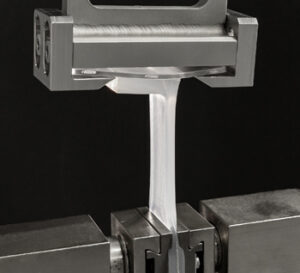WACKER presents self-adhesive liquid silicones for medical use at COMPAMED
Munich, Germany – At this year’s COMPAMED medical technology trade show, the chemicals group WACKER is showcasing silicone products for medical applications. The company is focusing on self-adhesive liquid silicone rubber for hard/soft combinations with polycarbonate and silicone adhesives for wound dressings and fixing aids. Such adhesive gels not only reduce the pain of dressing changes. High-strength adhesive products are also suitable for fixing sensors and medical aids, as a current study conducted by WACKER demonstrates. The company will present the results of the study at the trade fair. COMPAMED 2022 takes place in Düsseldorf, Germany, from November 14 to 17.
WACKER is presenting ELASTOSIL® LR 3078 at COMPAMED 2022. The self-adhesive liquid silicone rubber is suitable for manufacturing poly-carbonate hard/soft combinations. (photo: WACKER)
Pleasant to the touch, skin compatible and with good mechanical properties, silicone elastomers have been used in medical technology for many years. This high-tech material is very versatile: silicones are often used in the production of seals, tubes, catheters and orthopedic aids. In hard/soft combinations, too, which are typically made of rigid thermoplastics, manufacturers often choose silicones for the soft components. Silicone elastomers are chemically and biologically inert, can be easily sterilized, have high rebound resilience and good elasticity over a wide temperature range.
At this year’s COMPAMED, WACKER is showcasing a new self-adhesive liquid silicone rubber that bonds superbly to polycarbonate – a material that is widely used in medical technology due to its transparency. ELASTOSIL® LR 3078 is formulated such that, on curing, it bonds to the substrate but not to the injection molding tool. For this, WACKER uses a newly developed and patented self-adhe-sive technology that requires neither pre-treatment of the substrate surface nor bisphenol A-containing structures. By eliminating this substance class in the adhesion promoter, WACKER is improving industrial safety and enhancing consumer protection.
All the grades of this new product line can be readily processed by two-component injection molding, especially since they show only minimal mold fouling. This makes a substantial contribution to uninterrupted running of the injection-molding machine over long periods. It thereby allows precision manufacturing of geometrically complicated articles without the need for secondary finishing. Thanks to the fast curing of the new liquid silicone grades, injection molding cycle times are very short. ELASTOSIL® LR 3078 thus opens the way for further miniaturization of polycarbonate-silicone hybrid parts and for completely new product designs.
Cured products made of ELASTOSIL® LR 3078 have been success-fully tested for biocompatibility in selected tests according to ISO 10993 and US Pharmacopeia Chapter <88>, Class VI. In these tests, all the mechanical properties, as well as adhesion to polycarbonate, remain unchanged even on repeated steam sterilization at 134 °C. The new liquid silicones can thus be used to manufacture two-com-ponent medical parts, such as for medical diagnostics, for medication dispensing or minimally invasive diagnostic and surgical techniques.
The Munich-based chemical company WACKER is presenting the results of a current wear study at this year’s COMPAMED: It shows that the strong silicone adhesive SILPURAN® 2114 can also be used for fixing medical aids on the skin. (photo: WACKER)
Gentle silicone gel adhesives have a proven track record over many years as wound dressings. They are formulated so that the dressing can be removed with little pain and without damaging the tissue. However, silicone gels are not only used for atraumatic and low-pain wound dressings. In a recent study, WACKER was able to demon-strate that strong silicone adhesives can be used in medical applica-tions other than wound dressings, such as for fixing sensors, dosing equipment, ostomy bags or other medical devices.
At this year’s COMPAMED, WACKER is presenting the study results and the adhesives that were investigated. The focus is on foam wound dressings with two different adhesive layers: the standard silicone adhesive SILPURAN® 2100, with a peel adhesion of 2.7 Newton per 2.5 cm, determined as per EN 1939 in a 90° peel test on steel, and the strongly adhesive SILPURAN® 2114 silicone gel, which attains a peel adhesion of 3.5 Newton per 2.5 cm.
The wear study gives clear results: Thanks to its high adhesion values, SILPURAN® 2114 permits reliable fixation on the skin for several days without patients needing to significantly restrict their lifestyle, for example when washing or playing sport. Also, the adhesive does not leave residues on the skin. Fixation aids can be freely peeled off and reapplied. An incorrectly placed dressing still adheres reliably to the skin even after repositioning.
SILPURAN® 2114 is transparent and cures to form a soft, highly flexible material with a gel-like consistency. It is water-repellent, but breathable and gentle to the skin thanks to its permeability to water-vapor and gases. The product contains neither plasticizers nor stabilizers. Like all WACKER silicone adhesives, SILPURAN® 2114 is chemically inert and aging resistant. It can be readily sterilized with ethylene oxide.
SILPURAN® 2114 can be easily combined with selected polyolefin backing films. The peel force lies below 0.5 Newton per 2.5 cm. Release films can thus be safely removed without leaving residues. Wound dressings and fixation aids coated with SILPURAN® 2114 thus have a long shelf life. The release values of the silicone adhesive remain unchanged even after several months’ storage.

